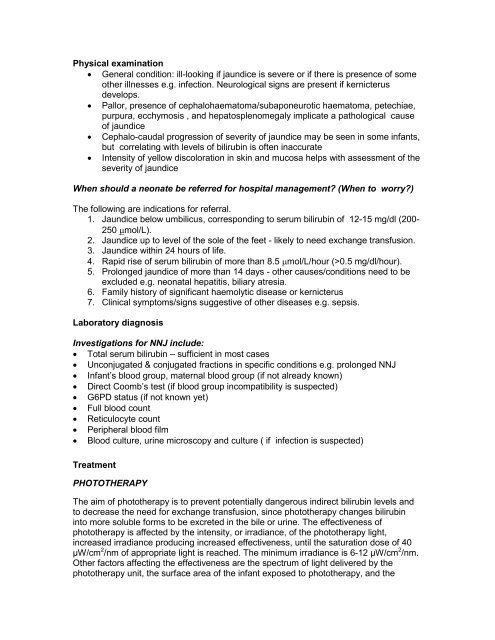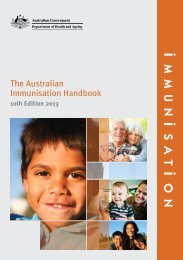Contents Chapter Topic Page Neonatology Respiratory Cardiology
Contents Chapter Topic Page Neonatology Respiratory Cardiology
Contents Chapter Topic Page Neonatology Respiratory Cardiology
Create successful ePaper yourself
Turn your PDF publications into a flip-book with our unique Google optimized e-Paper software.
Physical examination<br />
• General condition: ill-looking if jaundice is severe or if there is presence of some<br />
other illnesses e.g. infection. Neurological signs are present if kernicterus<br />
develops.<br />
• Pallor, presence of cephalohaematoma/subaponeurotic haematoma, petechiae,<br />
purpura, ecchymosis , and hepatosplenomegaly implicate a pathological cause<br />
of jaundice<br />
• Cephalo-caudal progression of severity of jaundice may be seen in some infants,<br />
but correlating with levels of bilirubin is often inaccurate<br />
• Intensity of yellow discoloration in skin and mucosa helps with assessment of the<br />
severity of jaundice<br />
When should a neonate be referred for hospital management? (When to worry?)<br />
The following are indications for referral.<br />
1. Jaundice below umbilicus, corresponding to serum bilirubin of 12-15 mg/dl (200-<br />
250 µmol/L).<br />
2. Jaundice up to level of the sole of the feet - likely to need exchange transfusion.<br />
3. Jaundice within 24 hours of life.<br />
4. Rapid rise of serum bilirubin of more than 8.5 µmol/L/hour (>0.5 mg/dl/hour).<br />
5. Prolonged jaundice of more than 14 days - other causes/conditions need to be<br />
excluded e.g. neonatal hepatitis, biliary atresia.<br />
6. Family history of significant haemolytic disease or kernicterus<br />
7. Clinical symptoms/signs suggestive of other diseases e.g. sepsis.<br />
Laboratory diagnosis<br />
Investigations for NNJ include:<br />
• Total serum bilirubin – sufficient in most cases<br />
• Unconjugated & conjugated fractions in specific conditions e.g. prolonged NNJ<br />
• Infant’s blood group, maternal blood group (if not already known)<br />
• Direct Coomb’s test (if blood group incompatibility is suspected)<br />
• G6PD status (if not known yet)<br />
• Full blood count<br />
• Reticulocyte count<br />
• Peripheral blood film<br />
• Blood culture, urine microscopy and culture ( if infection is suspected)<br />
Treatment<br />
PHOTOTHERAPY<br />
The aim of phototherapy is to prevent potentially dangerous indirect bilirubin levels and<br />
to decrease the need for exchange transfusion, since phototherapy changes bilirubin<br />
into more soluble forms to be excreted in the bile or urine. The effectiveness of<br />
phototherapy is affected by the intensity, or irradiance, of the phototherapy light,<br />
increased irradiance producing increased effectiveness, until the saturation dose of 40<br />
µW/cm 2 /nm of appropriate light is reached. The minimum irradiance is 6-12 µW/cm 2 /nm.<br />
Other factors affecting the effectiveness are the spectrum of light delivered by the<br />
phototherapy unit, the surface area of the infant exposed to phototherapy, and the
















